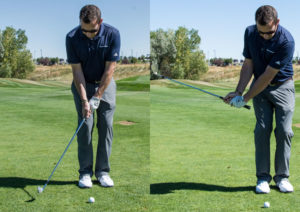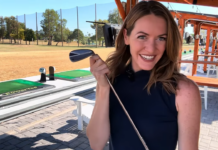JUST SAY NO … to using your lob wedge every time you’re around the green. It will be one of the best things you’ve done all year.
Here’s a truth and you may not like it: You have a problem and it’s killing your golf game.
Yes, you.
Whether you know it or not, you have an addiction – to golf, of course, which is wonderful and life-fulfilling, etc., etc.
But, specifically, you – YES, YOU – are addicted to your lob wedge and even though it slowly kills like your favorite ill-fated team whose season is “done” just a few weeks after it starts, you continue to reach for this high-lofted assassin every time you miss a green in regulation.

Now, go ahead, blame Phil Mickelson, whose career’s-worth of “impossible” floppers to a foot make ‘Ol Lofty look so easy, or the new wave of aerial-assault courses that often give no choice, or just blame it on the rain (because, if I have to explain the pop culture reference you deserve an excuse) – whatever the motivator, most of us use high-lofted wedges around the greens when we shouldn’t and it’s killing our scores!
Let’s first say I’ve also been prone to this since my junior golf days at a hilly, small-greened course in Michigan. The flop shot was around every corner and, honestly, it was just fun to launch the ball sky-high and stop it by its pitch mark.
But, as my game progressed and I’d play at different courses with bigger, flatter greens that didn’t need this shot, that’s all I knew and, oh, boy, if I didn’t execute …
It wasn’t until I turned professional, and really until I started coaching college golf, that I saw just how much more challenging this addiction was making it to score around the greens.
Not because I solely hit the high-launcher – the de-lofted-back-in-the-stance-low-spinner was my go-to.
Nor was it because I hadn’t ever been encouraged or taught to take a lower-lofted club and hit a true “bump-and-run” – my college coach was hell-bent on it.
It was purely because I had only used my “60” so long this was the lone club I was comfortable with, so I never deviated. As a professional golfer, no less!
 Of course, there are many times when the lob wedge is needed and the only option: When the ball is in deep rough (Quick Tip: Use more loft than you think you need in deep or thick rough … you can thank me later), or you’re “short-sided” with little green between you and the hole, or variables like green break and speed dictate no other choice.
Of course, there are many times when the lob wedge is needed and the only option: When the ball is in deep rough (Quick Tip: Use more loft than you think you need in deep or thick rough … you can thank me later), or you’re “short-sided” with little green between you and the hole, or variables like green break and speed dictate no other choice.
But for most cases where there’s enough green that the ball has a chance to roll to the hole like a putt, a lower-lofted club like a 7-, 8-, 9-iron, PW or hybrid (in some cases) should be used to chip.
Alright, we’re to the point so let’s go with it.

Using lower-lofted clubs for these shots helps in three simple ways:
- Allows for a shorter swing, thus less chance for golfer error.
- Allows for a more consistent prediction of spin. Or, in other words, less backspin on the ball that makes it easier to judge roll-out and how hard to swing … just like a putt.
- Allows for more error in contact, because as the ball rolls out like a putt with less clubhead speed and spin, less variance from mishits occurs, because – in simple terms – less can go wrong. Of course, a “skulled,” or very poor shot with either won’t result well, but you’ll be amazed just how much more room for error the lower-lofted clubs create in comparable mishits.
So, how do we translate these shots into our game, with confidence?
Step 1.
Learn when to use these clubs instead of the higher-lofted wedges.
On links-style courses, or firm-and-fast layouts with open approaches to the green, it may even be appropriate to use a 5-, 6-, 7-iron or hybrid from 30-50 yards away, because – again – the shorter the swing the more consistent, and the better chance a poor shot has for success with its room for contact error and predictable roll-out.
On more aerial-style courses like the one I grew up at, there may only be a few cases per round where the lie is decent enough (read: not buried in rough), with ample green to work with where it makes sense.
A good rule of thumb to learn this: Visualize the ball landing on the green just a yard or two and rolling out to the hole the rest of the way. Some shots may call for the 7- or 8-iron, etc., while others still call for a higher-lofted wedge.
Step 2.
Practice, practice, practice.
The technique of these shots is the same as a basic chip with a higher-lofted wedge, and while I’ve listed a few clubs as suggestions, you can explore other clubs in your bag that may work in various situations through trial and error.
And after enough practice, in choosing which club to use while on the course?
As it’s often said when you find the one you marry: “You’ll just know.”
Step 3.
Trust your expanded shot repertoire the next time you play. You won’t be sorry!
Quick anecdote to prove this:
 During my final year coaching the Men’s Golf team at Scottsdale Community College, we hosted the NJCAA National Championship at a Phoenix-area course that often calls for the bump-and-run.
During my final year coaching the Men’s Golf team at Scottsdale Community College, we hosted the NJCAA National Championship at a Phoenix-area course that often calls for the bump-and-run.
Knowing most of my guys were like I was back in the day, I targeted a tournament held at another links-type venue prior to the big event, and subsequently required our team to use the lower-lofted clubs every time the shot called for it.
Naturally, this didn’t go over well when introduced, but it forced my guys to practice these shots leading up to the test event, use them under pressure when it counted, and then ultimately trust their skills by the time we got to the Big Dance.
The end result?
We won the National Championship by 18 shots, largely in part to their efficient short games with the lower-lofted clubs around the greens.
Alright, so our little truth-drop wasn’t so bad, now, was it?
Let’s just think of this as a friendly intervention to know that, if you take these measures and lean on more than just your lob wedge around the green, your golf game will thank you for it.
Because, sometimes, it’s best to just say no.











Very smart and helpful. Thx
Jon – thanks for sharing this insight. I have a sophomore daughter in high school who is a very solid player. But EVERY time she misses a green, out comes the flopper!!!! Now, if only I could actually get her to read this article with some degree of authentic interest. May be too much to ask of a 15 year old girl! lol.
this is a excellent tip. I practice a lot on just off the green shots quite a bit. anywhere from 35yards to a couple feet. I will take 10 balls and hit a variety of clubs. If the lie is not buried, I discovered that I was much more accurate with a lower lofted club. Ie I had a 58/54/Gap wedge(50) from 5 yards off to 6 feet. The pin was 15 feet from the edge with a uphill slope. With a 58, maybe 2 balls within a couple feet, some 10 feet past or short. And all over the board on direction. About the same with the 54, only a little more accurate. The gap was mindblowing. I actually holed 1 to 2 balls in 10, on various distance and the pattern was very tight to the pin. Now if I practiced for hours and hours with the 58/56 I was able to improve the results. But I don’t have the time to spend with those wedges. Using a gap wedge/PW/8/etc and a little practice time to determine the rollout. I was able to get it closer moe consistently. I have found the extra time I spent trying to master the 58/54 is better spent on putting where you can make a big difference in scoring. I rarely 3 putt and the time spent on putting has dropped more strokes than I would ever get with the high lofted wedges.
This tip Is very helpful. In my own game and practice using a 58/54/gap(50)/PW(46) I was much more accurate with the gap and pw. Actually my gap is a goto inside 25 and the pin is not too close to the edge and it is not in thick rough, then hi loft is needed.. I practice a lot 10 yards to a few feet off the green, using 10 balls taking notes to how close, distance, accuracy to the pin. I found that I was inconsistent with the 58, some balls a couple feet, others up to 10 feet short or long and off target. The 54 I was a little tighter. The gap wedge was mindblowing. with less swing I could hole out 1 to 2 balls with every 10 ball group. Distance was tighter with some 10 ball groups being within 3 feet. Accuracy was much tighter. It was just simpler to do. The important thing is taking some time to practice with the lower loft and get a feel for the rollout. It is amazing how much roll a 8 iron will put on a ball compared to the gap. By going to the gap most the time I dropped at least 3 strokes. That along with more practice with putting dropped 7 strokes off my handicap. I did try practicing with the 58/54 to improve , but I found I had to spend quite a bit more time. Maybe 3 10 ball groups compared to 1 group with the gap. The gap was just easier to get on line to the pin.
The 7-iron chip-and-run from close to the green has served me well many a time.